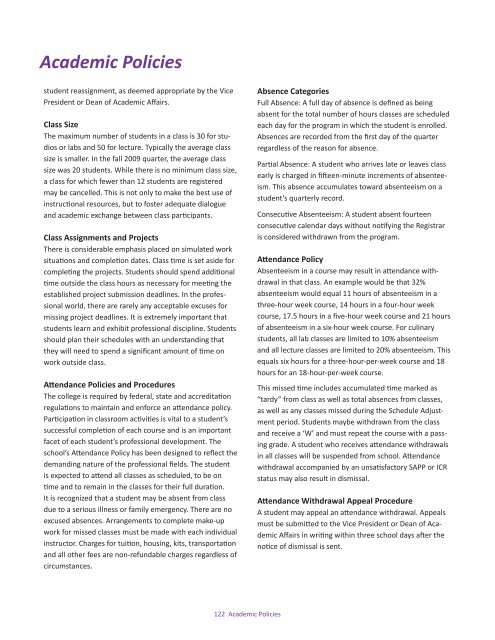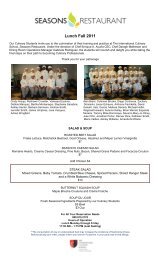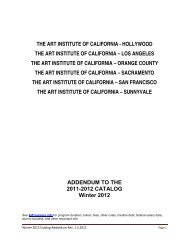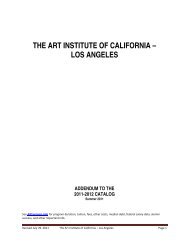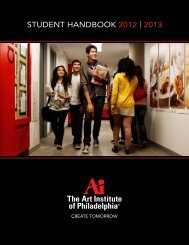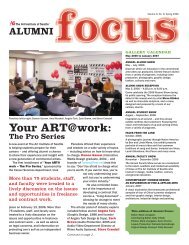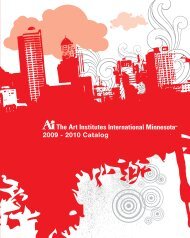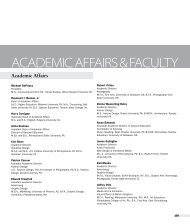Course Descripons - The Art Institutes
Course Descripons - The Art Institutes
Course Descripons - The Art Institutes
Create successful ePaper yourself
Turn your PDF publications into a flip-book with our unique Google optimized e-Paper software.
Academic Policies<br />
student reassignment, as deemed appropriate by the Vice<br />
President or Dean of Academic Aff airs.<br />
Class Size<br />
<strong>The</strong> maximum number of students in a class is 30 for studios<br />
or labs and 50 for lecture. Typically the average class<br />
size is smaller. In the fall 2009 quarter, the average class<br />
size was 20 students. While there is no minimum class size,<br />
a class for which fewer than 12 students are registered<br />
may be cancelled. This is not only to make the best use of<br />
instruc� onal resources, but to foster adequate dialogue<br />
and academic exchange between class par� cipants.<br />
Class Assignments and Projects<br />
<strong>The</strong>re is considerable emphasis placed on simulated work<br />
situa� ons and comple� on dates. Class � me is set aside for<br />
comple� ng the projects. Students should spend addi� onal<br />
� me outside the class hours as necessary for mee� ng the<br />
established project submission deadlines. In the professional<br />
world, there are rarely any acceptable excuses for<br />
missing project deadlines. It is extremely important that<br />
students learn and exhibit professional discipline. Students<br />
should plan their schedules with an understanding that<br />
they will need to spend a signifi cant amount of � me on<br />
work outside class.<br />
A� endance Policies and Procedures<br />
<strong>The</strong> college is required by federal, state and accredita� on<br />
regula� ons to maintain and enforce an a� endance policy.<br />
Par� cipa� on in classroom ac� vi� es is vital to a student’s<br />
successful comple� on of each course and is an important<br />
facet of each student’s professional development. <strong>The</strong><br />
school’s A� endance Policy has been designed to refl ect the<br />
demanding nature of the professional fi elds. <strong>The</strong> student<br />
is expected to a� end all classes as scheduled, to be on<br />
� me and to remain in the classes for their full dura� on.<br />
It is recognized that a student may be absent from class<br />
due to a serious illness or family emergency. <strong>The</strong>re are no<br />
excused absences. Arrangements to complete make-up<br />
work for missed classes must be made with each individual<br />
instructor. Charges for tui� on, housing, kits, transporta� on<br />
and all other fees are non-refundable charges regardless of<br />
circumstances.<br />
122 Academic Policies<br />
Absence Categories<br />
Full Absence: A full day of absence is defi ned as being<br />
absent for the total number of hours classes are scheduled<br />
each day for the program in which the student is enrolled.<br />
Absences are recorded from the fi rst day of the quarter<br />
regardless of the reason for absence.<br />
Par� al Absence: A student who arrives late or leaves class<br />
early is charged in fi � een-minute increments of absenteeism.<br />
This absence accumulates toward absenteeism on a<br />
student’s quarterly record.<br />
Consecu� ve Absenteeism: A student absent fourteen<br />
consecu� ve calendar days without no� fying the Registrar<br />
is considered withdrawn from the program.<br />
A� endance Policy<br />
Absenteeism in a course may result in a� endance withdrawal<br />
in that class. An example would be that 32%<br />
absenteeism would equal 11 hours of absenteeism in a<br />
three-hour week course, 14 hours in a four-hour week<br />
course, 17.5 hours in a fi ve-hour week course and 21 hours<br />
of absenteeism in a six-hour week course. For culinary<br />
students, all lab classes are limited to 10% absenteeism<br />
and all lecture classes are limited to 20% absenteeism. This<br />
equals six hours for a three-hour-per-week course and 18<br />
hours for an 18-hour-per-week course.<br />
This missed � me includes accumulated � me marked as<br />
“tardy” from class as well as total absences from classes,<br />
as well as any classes missed during the Schedule Adjustment<br />
period. Students maybe withdrawn from the class<br />
and receive a ‘W’ and must repeat the course with a passing<br />
grade. A student who receives a� endance withdrawals<br />
in all classes will be suspended from school. A� endance<br />
withdrawal accompanied by an unsa� sfactory SAPP or ICR<br />
status may also result in dismissal.<br />
A� endance Withdrawal Appeal Procedure<br />
A student may appeal an a� endance withdrawal. Appeals<br />
must be submi� ed to the Vice President or Dean of Academic<br />
Aff airs in wri� ng within three school days a� er the<br />
no� ce of dismissal is sent.


